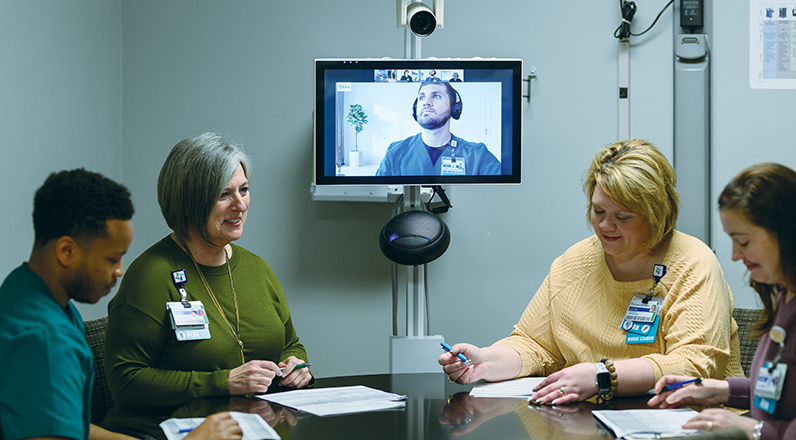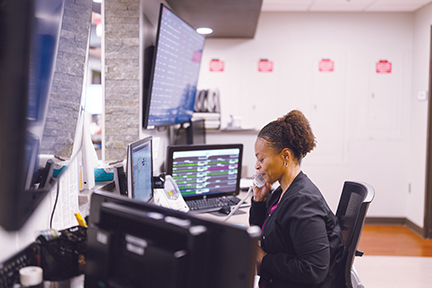
Patients at Saint Joseph Hospital in Lexington, Kentucky, are getting some of their care from nurse Corey Ross, even though he's working from hundreds of miles away.
Ross is part of a pioneering effort at Saint Joseph known as virtually integrated care, in which nurses on the floor are joined electronically by nurses whose presence is activated with a simple tap on a wall-mounted screen. Hospital officials say the system helps address the nationwide nursing shortage and extend the capabilities of nurses.

"It's about putting together new models that add technology to help the nurses at the bedside," says Kathleen Sanford, executive vice president, chief nursing officer, for CommonSpirit Health, which selected Saint Joseph as a pilot site. Saint Joseph is within CHI Saint Joseph Health, part of CommonSpirit Health.
CommonSpirit Health is one of several systems in the Catholic health care ministry using virtual technology to enhance their inpatient nursing care. For example, Providence St. Joseph Health and Trinity Health have created teams with nurses joining through telehealth to give bedside care providers more time for hands-on care. The same is true for Intermountain Health, a system that includes Catholic hospitals that were once the separate SCL Health system.

At Saint Joseph, Melissa Bennett, chief operating officer/chief nursing executive of CHI Saint Joseph Health, Kentucky, explains the simplicity of the system the hospital is piloting. "If I'm a bedside person, I walk into the room, I can call the virtual nurse. I simply tap the screen," she says.
The screen tap sends an audible alarm to the virtual nurse. That virtual nurse, for privacy, will come on verbally and introduce himself or herself, and then ask permission to come on to the screen.
"Nurses utilize the virtual nurse. Patients and family utilize the virtual nurse. Physicians utilize the virtual nurse, technical staff pharmacy, care management," Bennett says. "Everyone has the ability to tap into that virtual nurse."
For Ross and other virtual nurses, the technology provides innovative, more efficient ways to use their skills and their time. "I get many, many calls throughout the day from patients and their families, and it's great because that's what we're here for," he says.
COVID and the nursing shortage
The virtual nursing idea, Sanford says, goes back to 2008, as part of the long-term plan of Catholic Health Initiatives, the system that along with Dignity Health merged in 2019 to form CommonSpirit
Health. Its timeline projected that by 2020 virtual nursing would be a part of the system's acute care. In 2011 a white paper forecast how virtual nursing could play a major role in the future, and in 2016 the system got a patent.

Then came the COVID-19 pandemic and the nursing shortage. Sanford says CommonSpirit realized that "we had better get started on new models. The thought was that with this shortage, we needed to do something totally different and take advantage of the new technologies that were emerging. So we did."
Bennett says Saint Joseph started virtually integrated care with a small set of patients in December 2022 and quickly expanded, in terms of both the rooms involved and the focus of the program itself.
"When we first went live, we were really focused on making sure we had a good connection, and that the image was clear, and that they could hear everything," Bennett says. "Then the question became: Is this going to work?"
That question was quickly answered. "If I took this away from the providers, they would be distraught," Bennett says. "The providers recognized how valuable it is to have that point person who's helping to connect all the dots."

Anthony A. Houston, CEO of CHI Saint Joseph Health, Kentucky, says the combination of in-person and on-screen attention has worked well.
"What you find is people really enjoy the experience," he notes. "And when we talk to our caregivers, they're also enjoying the experience a lot. We're touching the patients in a way that we just couldn't touch them before. It's really powerful and exciting."
Virtually from the start
From the nursing point of view, Ross says that expanding the treatment team virtually helps both him and his patients, even though he works remotely.
"When we do our admissions, we make sure to explain what our role is in the plan of care, because I feel like it comforts them," he says.
Ross says virtual nurses tell patients: "We're here at all times to answer any questions you might have. If you have any concerns that you might need to be conveyed to a doctor, I can call and contact the doctor any time. I can go through your medications with you to let you know more if you have questions about those. And then I can review the doctor's notes."
Ross credits his in-person experience in several units of the hospital, before he moved to northern Indiana, with helping him become comfortable and be successful working virtually, especially in a time when nurses aren't always easy to find.
"It's different than floor nursing, I will say that. The time management aspect of it is just as critical, because we have larger patient loads than the typical floor nurse might have," he says. "We start working towards discharge from the time they're admitted. So we need to identify those barriers. Does that patient need things at home? Do they have a place to go when they leave the hospital? How are they going to get there? Just identifying patient needs right off the bat is something we're able to take hands on."

Nurse Tendai Kujinga had to adjust not only to transitioning from floor nurse to virtual nurse but to an atmosphere in Kentucky that varies from that in her former job in Zimbabwe. She learned quickly how to handle the differences.
"Initially, I thought it's all about just sitting on the screen and just talking to your patients. And I wanted to do much of the physical work on the floor," Kujinga says. "But when I got into it, I realized there's a lot of work, because I have to talk to doctors, I have to talk to nurses, I have to talk to therapists, I have to talk to my managers — every problem that needs to be solved.
"You have to know everything. So that's how different it was for me. There's a lot that I learned. And there's a lot of help that I gave my colleagues and my patients."
And for patients, Kujinga says: "Most of them were like, 'Oh wow, this is really cool. I like this because I can just talk to somebody.'"
Expanding screens
The virtual nurse software used at Saint Joseph is a proprietary system. The system also provides virtual admission, discharge and transfer nursing services. It is used now in other CommonSpirit facilities and it
is headed to more, with plans for virtual nursing in all CommonSpirit markets by the end of this year.
The expansion, Sanford says, will not leave traditional best medical practices behind.
"We are never not going to be hands-on in nursing because people who come to the hospital are sick enough to need hands-on," Sanford says. "This is just an addition to our team."
And it's a good one, she says, based on patient surveys and evaluations, which have shown improvements in areas such as communication and discharge information.
Sanford expects the next generation of nurses to be well-versed in virtual processes and other advances, both current ones and those on the horizon. "We have partnerships with a couple of different universities who are just now beginning to teach their students that they will be going into a different environment," she says.
And in that environment, Bennett adds, the real benefits to the nursing staff are easy to spot.
She says: "What we hear from our nurses is this: I have the ability to go home at the end of the day and feel joy — joy that I was able to meet the needs of my patients, because I know that I've got that extra support virtually to help make sure everything is connected."
